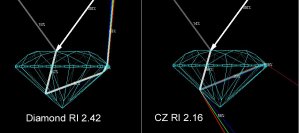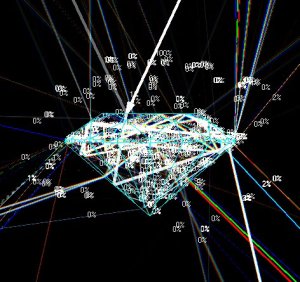You are using an out of date browser. It may not display this or other websites correctly.
You should upgrade or use an alternative browser.
You should upgrade or use an alternative browser.
shallow looks better when dirty......shy?
- Thread starter rosy
- Start date
- Status
- Not open for further replies. Please create a new topic or request for this thread to be opened.
- Joined
- Aug 15, 2000
- Messages
- 18,492
Yes, I am guilty as charged.
Dirt on the pavilion of a diamond has the effect of lowering diamonds high Refractive Index and that is the main reason why diamond sparkles so much.
This means that you get more leakage of the type shown here.
To try this - wet a diamond pavilion and you will see a large leakage area inside the table region on the far side as you tilt the stone.
Shallower diamonds show less of this large leakage area.
The 2 images are of the same proportioned stones - left side is diamond and the right side is modeled CZ.

Dirt on the pavilion of a diamond has the effect of lowering diamonds high Refractive Index and that is the main reason why diamond sparkles so much.
This means that you get more leakage of the type shown here.
To try this - wet a diamond pavilion and you will see a large leakage area inside the table region on the far side as you tilt the stone.
Shallower diamonds show less of this large leakage area.
The 2 images are of the same proportioned stones - left side is diamond and the right side is modeled CZ.

Okay, thanks for posting the models. I understand now. Another question I have is when a diamond is dirty will it disguise it''s true body color? For example if I have an F diamond & it gets dirty, will it look the same as an H color that''s dirty also?
- Joined
- Aug 15, 2000
- Messages
- 18,492
I do not think dirt has much effect Rosy
- Joined
- Aug 15, 2000
- Messages
- 18,492
It depends more on the color of the gunk.
White soap powder caan help, but if you use colored oils and soaps etc - well it might be worse?
White soap powder caan help, but if you use colored oils and soaps etc - well it might be worse?
As far as I know, a coating of dirt, oil, and/or water
makes any diamond less fiery and less brilliant than when the diamond is clean.
In theory, oil and water have more effect on steeper diamonds than on shallower diamonds.
Garry's illustration tries to show why.
The illustration is only half-right,
but it is probably the best that Garry's copy of DiamondCalc can do.
One Theory
1) The "dirt" is actually a smooth film, with an index of refraction between that of air and that of diamond.
2) The oil or water film does not change the index of refraction inside the diamond itself.
3) The oil or water on the pavillion does change the "effective index of refraction" between the diamond and the film. Garry's illustration tries to show this "effective index" as well as DiamondCalc allows.
4) The oil or water on the pavillion is much more important than the oil or water on the crown.
5) In a clean diamond, many rays reflect off the pavillion back into the diamond. Some rays bounce once off the pavillion; other rays bounce twice off the pavillion. (And some rays leak out the bottom, even in a clean ideal-cut diamond.)
6) In a slightly dirty diamond, some of the rays (that ought to have been reflected once by the pavillion) pass out of the pavillion into the oil or water. Most of these rays never make it out of the oil or water. Instead, these rays bounce back and forth between the air/water surface and the water/diamond surface until they are absorbed.
7) We can modify the diamond cut to adjust for the missing singly reflected rays. One adjustment is to make the crown angle shallower and the table larger (for a given pavillion angle). Another adjustment is to make the pavillion angle slightly shallower (for a given crown angle).
For more details, please see posts 8-13 of the "Dirty Diamonds" thread on DiamondTalk:
http://www.diamondtalk.com/forums/showthread.php?t=10178#post79432
and play with increasing the girdle thickness in Tolkowsky's Diamond Design:
http://www.folds.net/diamond
-- Jasper Paulsen
http://www.folds.net/diamond
makes any diamond less fiery and less brilliant than when the diamond is clean.
In theory, oil and water have more effect on steeper diamonds than on shallower diamonds.
Garry's illustration tries to show why.
The illustration is only half-right,
but it is probably the best that Garry's copy of DiamondCalc can do.
One Theory
1) The "dirt" is actually a smooth film, with an index of refraction between that of air and that of diamond.
2) The oil or water film does not change the index of refraction inside the diamond itself.
3) The oil or water on the pavillion does change the "effective index of refraction" between the diamond and the film. Garry's illustration tries to show this "effective index" as well as DiamondCalc allows.
4) The oil or water on the pavillion is much more important than the oil or water on the crown.
5) In a clean diamond, many rays reflect off the pavillion back into the diamond. Some rays bounce once off the pavillion; other rays bounce twice off the pavillion. (And some rays leak out the bottom, even in a clean ideal-cut diamond.)
6) In a slightly dirty diamond, some of the rays (that ought to have been reflected once by the pavillion) pass out of the pavillion into the oil or water. Most of these rays never make it out of the oil or water. Instead, these rays bounce back and forth between the air/water surface and the water/diamond surface until they are absorbed.
7) We can modify the diamond cut to adjust for the missing singly reflected rays. One adjustment is to make the crown angle shallower and the table larger (for a given pavillion angle). Another adjustment is to make the pavillion angle slightly shallower (for a given crown angle).
For more details, please see posts 8-13 of the "Dirty Diamonds" thread on DiamondTalk:
http://www.diamondtalk.com/forums/showthread.php?t=10178#post79432
and play with increasing the girdle thickness in Tolkowsky's Diamond Design:
http://www.folds.net/diamond
-- Jasper Paulsen
http://www.folds.net/diamond
- Joined
- Aug 15, 2000
- Messages
- 18,492
Thankyou Jasper.
For those who do not know Jasper, he is a super bright mathematician who did an excellent review of Tolkowsky showing that (among other things) that if you adjust crown angle it can be compensated for by an inverse adjustment in pavilion angle. i thought i discovered this idea - but it was alwways buried in tolkowsky''s work. I have also met many older cutters who lament the invention of scanners and grading reports that took away a cutters creativity to apply these laws of nature and make the best looking diamond with the biggest yeild out of each rough diamond.
Now GIA and AGS will shortly introduce new grading systems that will allow for this creativity again.
For those who do not know Jasper, he is a super bright mathematician who did an excellent review of Tolkowsky showing that (among other things) that if you adjust crown angle it can be compensated for by an inverse adjustment in pavilion angle. i thought i discovered this idea - but it was alwways buried in tolkowsky''s work. I have also met many older cutters who lament the invention of scanners and grading reports that took away a cutters creativity to apply these laws of nature and make the best looking diamond with the biggest yeild out of each rough diamond.
Now GIA and AGS will shortly introduce new grading systems that will allow for this creativity again.
- Joined
- Aug 15, 2000
- Messages
- 18,492
Actually Jasper I usually try to simplify the DiamCalc images as much as possible for educational purposes.Date: 1/2/2005 5:54:12 PM
Author: jasper
Garry''s illustration tries to show why.
The illustration is only half-right,
but it is probably the best that Garry''s copy of DiamondCalc can do.
-- Jasper Paulsen
http://www.folds.net/diamond
Whislt I agree with everything you have said i shoul;d add that there is almost always some % of light that manages to find its way out the pavilion - that is why the %''s rarely add up to 100%.
If I sought to make the issue realistic and as complex as most ray paths actually are - then we can get images like this which are of less instructional benefit.
So may I add - that at every possible intecpt of light on a dirty pavilion, there will be a greater amount of leakage than in the case of a clean diamond - and Rosy - that means you are looking parrtly at the dirty pavilion from many directions - and partly at light that has entered the crown.
BTW - there is almost always less dirt on the crown of a diamond because the crown rubs on things because of the fact that it is exposed - so it is usually much cleaner than the pavilion.
Finally, Sergey has promised to make an experimantal version of DiamCalc to study dirty pavilions - but we all have heaps on at present.

Wow Jasper & Cut Nut, thanks for the explanations & information. It is very scientific but not entirely difficult to understand. I think I have witnessed this first hand, in another post I explained that my sister has a deep diamond & when the pavillion is dirty it barely sparkles. I had a shallow diamond 59% depth 60% table that still managed to sparkle even when the pavillion was dirty, although it sparkled white light & not as much colored light, probably due to the large table. Thanks for explaining, you gents are extremely helpful!
- Status
- Not open for further replies. Please create a new topic or request for this thread to be opened.
Celebrating Mothers And Mentors This Mother's Day Celebrating Mothers And Mentors This Mother's Day - 05/05
Celebrating Mothers And Mentors This Mother's Day - 05/05

Did You Miss the April 2024 Jewels of the Weeks?
Did You Miss the April 2024 Jewels of the Weeks? - 04/26
Did You Miss The Throwback Thursdays For April 2024?
Did You Miss The Throwback Thursdays For April 2024? - 04/25



300x240.png)